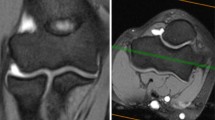Abstract
Purpose
The typical anatomical illustration of the trochlear notch articular surface includes a transverse rough non-articular ridge which separates the olecranon and coronoid part of the joint. This transverse ridge, the “bare area”, is not covered by cartilage and represents the optimal entry point for olecranon osteotomies. Aim of the present study was to encounter the anatomical variations in the morphology of the trochlear notch articular surface.
Methods
Two-hundred seventy-three dried ulnae were inspected and a qualitative classification of the variations of the trochlear notch articular surface was done. Correlation to gender and side was examined.
Results
Three distinct morphological patterns were observed. Separate olecranon and coronoid facets (Type I) were the most common pattern (165/273, 60.4%). Partial fusion of olecranon and coronoid facets (Type II) was observed in 75 out of 273 bones (27.5%), while a single olecranon and coronoid facet (Type III) was present in 33 out of 273 bones (12.1%). The occurrence of Type II and III was significantly more common in females (p < 0.001).
Conclusions
The most common morphological pattern of the proximal ulna articular surface was the olecranon and coronoid facets separated by the transverse ridge, which is considered as the typical anatomical pattern. The partial fusion of olecranon and coronoid facets was the second most common pattern (27.5%) and the single olecranon and coronoid facet with no transverse ridge present was the rarest one (12.1%). These variations affect the area covered by cartilage. They are noticeable in an elbow MRI and they may have implications on olecranon osteotomy. Absence of the transverse ridge may confuse the surgeon during elbow arthroscopy.


Similar content being viewed by others
References
Barel PD, Hanel PD (2011) Fractures of the distal humerus. In: Green DP, Wolfe SW (eds) Green’s operative hand surgery. Elsevier/Churchill Livingstone, Philadelphia, pp 745–782
Canale ST, Beaty JH (2013) Fractures and dislocations in children. In: Canale ST, Beaty JH, Campbell WC (eds) Campbell’s operative orthopaedics. Elsevier/Mosby, Philadelphia, pp 1365–1522
Keats TE, Anderson MW (2006) The forearm. In: Keats TE, Anderson MW (eds) Atlas of normal roentgen variants that may simulate disease. Mosby, St. Louis, pp 546–576
Kieffer EM, Bouchaib J, Bierry G, Clavert P (2014) CT arthrography and anatomical correlation of the bare area of the ulnar trochlear fossa: a risk of misdiagnosis of cartilage ulcerations. Surg Radiol Anat 36:481–486. https://doi.org/10.1007/s00276-013-1200-7
Milz S, Eckstein F, Putz R (1997) Thickness distribution of the subchondral mineralization zone of the trochlear notch and its correlation with the cartilage thickness: an expression of functional adaptation to mechanical stress acting on the humeroulnar joint? Anat Rec 248:189–197
Oberländer W, Breul R, Kurrat HJ (1984) Transverse groove of the elbow joint. A biomechanical interpretation of its origin. Z Orthop Ihre Grenzgeb 122:682–685. https://doi.org/10.1055/s-2008-1045051
Perez EA (2013) Fractures of the shoulder, arm, and forearm. In: Canale ST, Beaty JH, Campbell WC (eds) Campbell’s operative orthopaedics. Elsevier/Mosby, Philadelphia, pp 2829–2916
Ring D, Jupiter JB (2011) Fractures of proximal ulna. In: Green DP, Wolfe SW (eds) Green’s operative hand surgery. Elsevier/Churchill Livingstone, Philadelphia, pp 821–836
Rosenberg ZS, Beltran J, Cheung Y, Broker M (1995) MR imaging of the elbow: normal variant and potential diagnostic pitfalls of the trochlear groove and cubital tunnel. AJR Am J Roentgenol 164:415–418. https://doi.org/10.2214/ajr.164.2.7839980
Standring S, Gray H (2008) Elbow. In: Standring S, Gray H (eds) Gray’s anatomy: the anatomical basis of clinical practice. Churchill Livingstone/Elsevier, Edinburgh, pp 1507–1522
Standring S, Gray H (2008) Forearm. In: Standring S, Gray H (eds) Gray’s anatomy: the anatomical basis of clinical practice. Churchill Livingstone/Elsevier, Edinburgh, pp 1523–1556
Tillmann B (1978) A contribution to the functional morphology of articular surfaces. Norm Pathol Anat (Stuttg) 4:1–50
Wang AA, Mara M, Hutchinson DT (2003) The proximal ulna: an anatomic study with relevance to olecranon osteotomy and fracture fixation. J Shoulder Elb Surg 12:293–296. https://doi.org/10.1016/mse.2003.S1058274602868033
Author information
Authors and Affiliations
Corresponding author
Ethics declarations
Conflict of interest
The authors declare that they have no conflict of interest.
Additional information
Publisher's Note
Springer Nature remains neutral with regard to jurisdictional claims in published maps and institutional affiliations.
Rights and permissions
About this article
Cite this article
Totlis, T., Otountzidis, N., Papadopoulos, S. et al. Ulnar trochlear notch articular surface has three morphological patterns: a neglected major anatomical feature. Surg Radiol Anat 41, 1333–1336 (2019). https://doi.org/10.1007/s00276-019-02310-y
Received:
Accepted:
Published:
Issue Date:
DOI: https://doi.org/10.1007/s00276-019-02310-y




